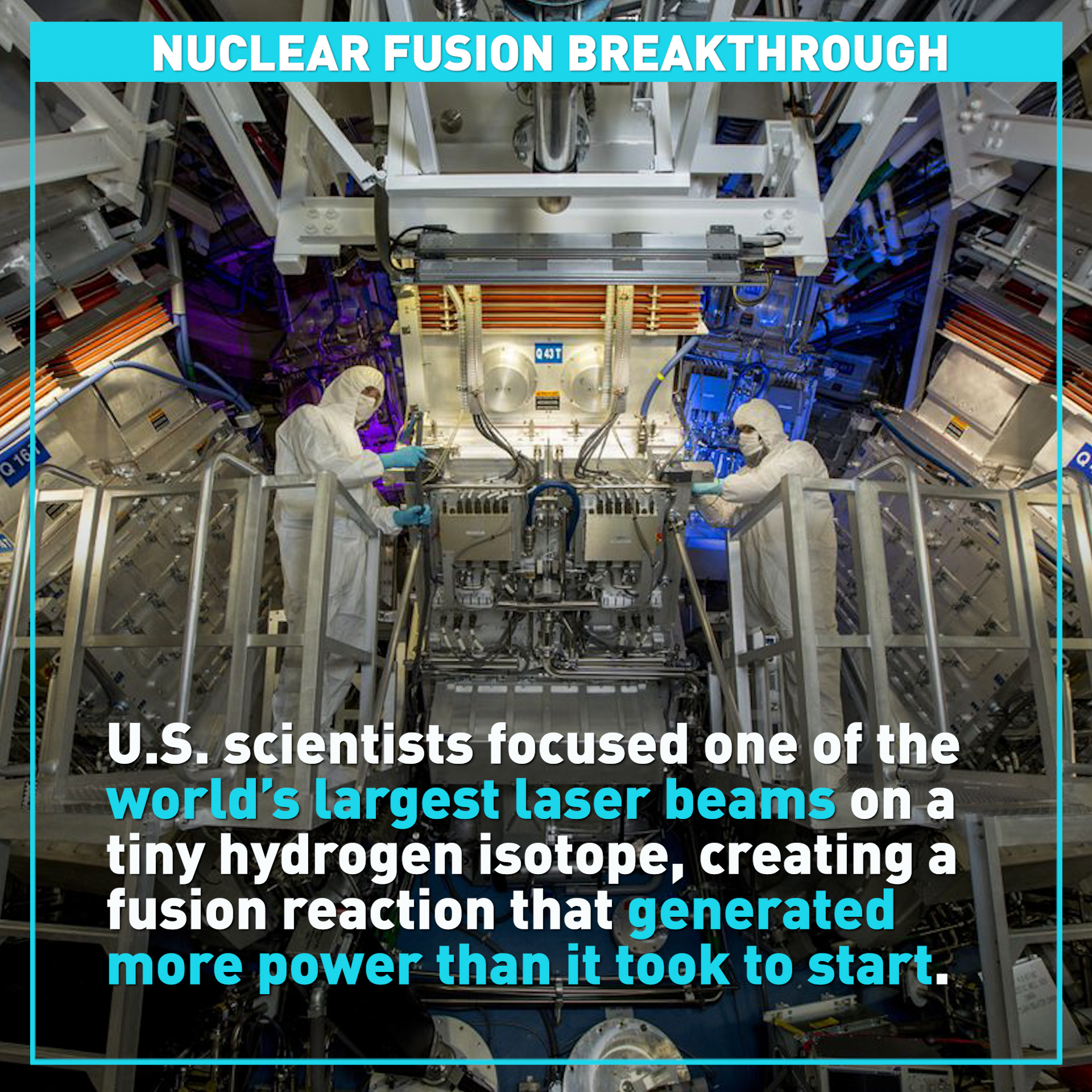
Click arrows to view gallery
Click arrows to view gallery
U.S. scientists from the Lawrence Livermore National Laboratories announced a breakthrough in nuclear fusion energy on Tuesday, potentially a step toward one day harnessing the process that fires the sun to generate carbon-free electricity as the world struggles with climate change.
Scientists at the lab in California on December 5 for the first time briefly achieved a net energy gain in a fusion experiment using lasers, the U.S. Energy Department said. The scientists focused a laser on a target of fuel to fuse two light atoms into a denser one, releasing the energy.
Kimberly Budil, the director of Lawrence Livermore, told reporters at an Energy Department event that science and technology hurdles mean commercialization is probably not five or six decades away, but sooner. "With concerted effort and investment, a few decades of research on the underlying technologies could put us in a position to build a power plant," Budil said.
Scientists have known for about a century that fusion powers the sun and have pursued developing fusion on Earth for decades.
The experiment briefly achieved what's known as fusion ignition by generating 3.15 megajoules of energy output after the laser delivered 2.05 megajoules to the target, the Energy Department said.
Arati Prabhakar, director of the White House Office of Sciences and Technology Policy, who heard about fusion at Livermore when she worked there briefly in 1978 as a teenager, said the experiment represents a "tremendous example of what perseverance can achieve."
Nuclear scientists outside the lab said the achievement will be a major stepping stone, but there is much more science to be done before fusion becomes commercially viable.
"This is one igniting capsule (of fuel) one time," Budil said about the experiment. To realize commercial fusion energy you have to... be able to produce many, many fusion ignition events per minute."
The electricity industry cautiously welcomed the step, though emphasized that in order to carry out the energy transition, fusion should not slow down efforts on building out other alternatives like solar and wind power, battery storage and nuclear fission. "It's the first step that says 'Yes, this is not just fantasy, this can be done, in theory,'" said Andrew Sowder, a senior technology executive at EPRI, a nonprofit energy research and development group.

Click arrows to view gallery
Click arrows to view gallery
Quick Q&As about nuclear fusion
1. What is fusion energy?
Fusion occurs when two light atoms, such as hydrogen, are heated to extreme temperatures of 100 million degrees Celsius (180 million Fahrenheit) and then fuse into one heavier atom, releasing large amounts of energy. It is different from fission, in which a reactor shoots a neutron into an atom of uranium, splitting into two smaller atoms.
2. Will fusion help fight climate change?
Potentially. Besides vastly ramping up the energy from fusion reactions, scientists need to produce them multiple times per second on a constant basis.
Scaling that process up to a power plant and building plants big enough to cover a significant chunk of the world's growing electricity demand would take momentous efforts requiring materials, land and clear regulations for industry. Politicians supporting the existing fuels and infrastructure may be resistant to rapid change.
As the quest for fusion energy develops over a decade or potentially much longer, countries should continue aggressive moves into wind and solar power, energy storage, including batteries, next generation fission power and other alternatives to reduce dependence on fossil fuels, scientists and environmentalists say.
A big advantage of fusion is it will most likely produce little radioactive waste compared to fission.
3. What other kinds of fusion energy are being developed?
Private companies have raised about $5 billion from investors, from individuals to oil companies, and public funding, according to the Fusion Industry Association. Eight companies, including Focused Energy and First Light Fusion, aim to use lasers to initiate fusion reactions.
About 15 companies, including Commonwealth Fusion Systems and TAE Technologies, aim to use powerful magnets to confine fusion fuel in the form of plasma, a fourth state of matter that contains charged particles.
About 10 companies are trying other methods, including a combination of magnets and lasers.
(With input from Reuters)
For more, check out our exclusive content on CGTN Now and subscribe to our weekly newsletter, The China Report.